|
Music and the Mechanical Age
by
Bob Brooke
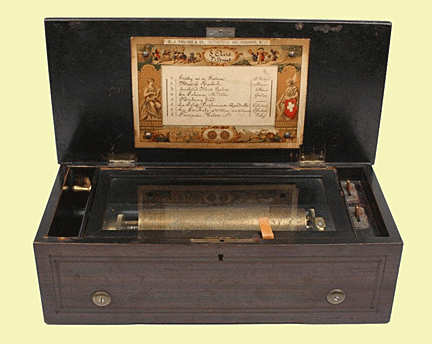 Up
until 1800, the only music people heard was made by them, playing
musical instruments. Daughters of wealthy families learned to play
musical instruments as part of their cultural education. And families
gathered in the parlor or music room after dinner to listen to music or
sing along. But with the invention of the music box, everyone had the
opportunity to have music in their home. Up
until 1800, the only music people heard was made by them, playing
musical instruments. Daughters of wealthy families learned to play
musical instruments as part of their cultural education. And families
gathered in the parlor or music room after dinner to listen to music or
sing along. But with the invention of the music box, everyone had the
opportunity to have music in their home.
When people think of mechanical music, most think of music boxes, for
not only are they still made today, they were also made in large numbers
from about beginning of the 19th to the early 20th century. The term
“music box,” itself, covers a variety of mechanical music inventions,
including: cylinder and disc boxes that played tunes on steel combs,
reproducing and player pianos, violin-playing machines, clocks with
mechanical mechanisms, musical toys and novelties, coin-operated
nickelodeons, orchestrions, fairground and dance organs, and even
organ-grinder's monkey organs. "
Essentially, mechanical music is a live performance of music, played by
a machine, without any human intervention. Its invention allowed people
to enjoy music before the development of electricity, when the only
option was a live performance, or creating your own music
The Origins of Mechanical Music
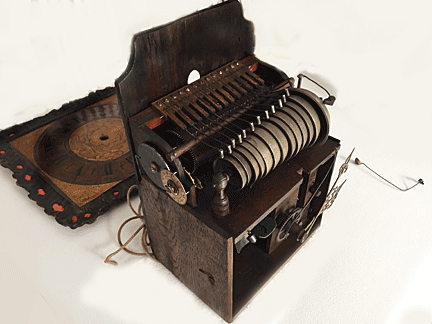 The
origins of mechanical music go as far back as the 14th century, with the
invention of the carillon, which automatically played music on tuned
bells actuated by hammers on levers actuated by a pinned drum. Primarily
used in churches to play hymns, the drum could be programmed to play
different song selections by moving the pins from one location to
another. The
origins of mechanical music go as far back as the 14th century, with the
invention of the carillon, which automatically played music on tuned
bells actuated by hammers on levers actuated by a pinned drum. Primarily
used in churches to play hymns, the drum could be programmed to play
different song selections by moving the pins from one location to
another.
With the dawn of the 15th century came the mechanical pipe organ, an
instrument which, through valves actuated by pins on the drum, allowed
selected pipes to play organ music mechanically. During the 16th
century, the mechanical pipe organ became widely popular in Europe and
soon expanded beyond churches and public buildings to the homes of the
wealthy. Before long, cabinetmakers began producing large desks and
cabinets to encase them. And famous musicians, including Beethoven,
Handel and Mozart, wrote pieces specifically for these mechanical
organs. I
It was the late 18th century before another significant change happened
to mechanical music by way of Antoine Favre, a Geneva clockmaker who
patented his "means for making carillons without bells or hammers" in
1796.
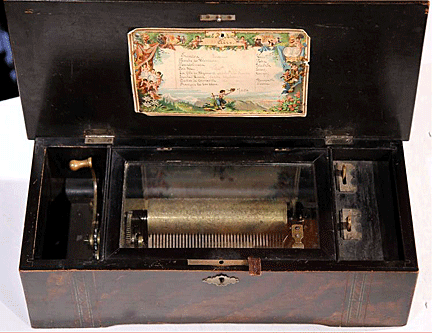
Favre's invention paved the way for cylinder boxes, the basis of which
is a comb of hard steel with a series of tuning forks or teeth, which
graduated from long and thick to short and thin. Pins, placed on a
rotating cylinder, plucked the teeth, producing a variety of tunes when
the cylinder was moved sideways..
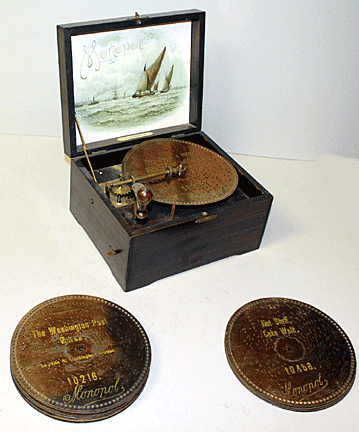 From
the late 18th to the late 19th century, the industry saw many advances
in technology which influenced the development of cylinder boxes.
Eventually makers were able to produce over 20 different musical effects
by changing the size, placement, tuning, and arrangement. of the musical
combs and pin placement on the cylinder. From
the late 18th to the late 19th century, the industry saw many advances
in technology which influenced the development of cylinder boxes.
Eventually makers were able to produce over 20 different musical effects
by changing the size, placement, tuning, and arrangement. of the musical
combs and pin placement on the cylinder.
While the cylinder music box revolutionized the industry, it had its
limitations. Though interchangeable cylinders allowed for the playing of
different tunes, it was a somewhat cumbersome process. All that changed
in the late 1880s with the introduction in Germany of the disc musical
box. This revolutionized the industry because of two unique qualities.
Instead of the slow and delicate process of inserting pins in cylinders,
the discs could be stamped out by machine. Also, the discs could be
easily changed on the machines thus making it possible for people to
hear the latest tunes.
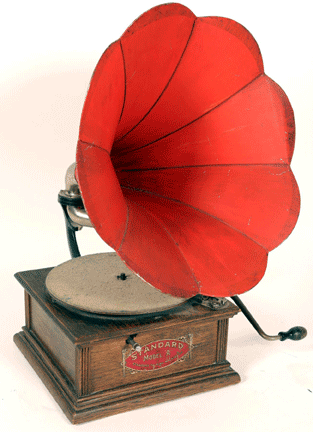 Manufacturers
mass-produced the disc box from 1885 to around 1915, with sizes ranging
from 4 to 32 inches. After a time, they began making music boxes that
changed discs automatically. In America, the Regina Company of New
Jersey produced them from around 1894 to the start of World War I and
captured 90 percent of the market. Though Regina produced many different
models which played discs that ranged in sizes from 8 to 32 inches,
boxes of the 15-inch disc size were the bulk of its business. . Manufacturers
mass-produced the disc box from 1885 to around 1915, with sizes ranging
from 4 to 32 inches. After a time, they began making music boxes that
changed discs automatically. In America, the Regina Company of New
Jersey produced them from around 1894 to the start of World War I and
captured 90 percent of the market. Though Regina produced many different
models which played discs that ranged in sizes from 8 to 32 inches,
boxes of the 15-inch disc size were the bulk of its business. .
While the 19th century also witnessed the development of many other
forms of mechanical music, none could hold their own against the
evolution of the phonograph. By the 1920s, the popularity of music boxes
had declined.
Types of Mechanical Musical Instruments
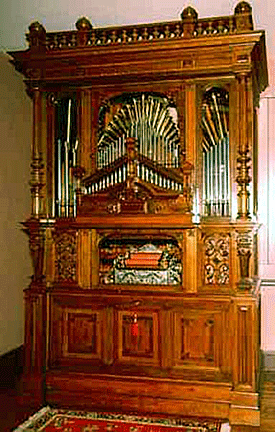 At
the turn of the century, no high-class dance hall, restaurant, or hotel
could possibly go without fine music. While across Europe and the United
States, impressive orchestrions played the hits of the day, other
mechanical instruments catered to a variety of music tastes and styles. At
the turn of the century, no high-class dance hall, restaurant, or hotel
could possibly go without fine music. While across Europe and the United
States, impressive orchestrions played the hits of the day, other
mechanical instruments catered to a variety of music tastes and styles.
Experts consider the Hupfeld Orchestrion the absolute best of any of the
self-playing instruments. Its superb musicality and precise German
engineering make it music absolutely breathtaking. Unfortunately, World
War I’s toll on Germany's economy significantly hindered Hupfeld's
production of these instruments. And after ceasing operations in the
late 1920s, World War II resulted in many instruments being scrapped for
metal and possibly even bombed during raids.
Violin orchestrions are certainly incredible to watch as well as listen
to. Hupfeld's Phonoliszt-Violina is almost haunting in its ability to
accurately play with human-like expression, this type of orchestrion
being one of the most sought-after instruments in all of automatic
music.
The Mills Violano was the United States's answer to a violin orchestrion.
Hailed as one of the greatest inventions of the early 20th century, this
machine differed from almost every other mechanical instrument being
electrically instead of pneumatically operated. This instrument was so
popular that experts estimate that around 1,000 of them still exist.
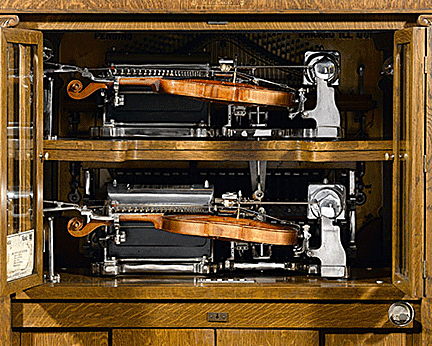
The unique Welte 4 Concert Orchestrion,
with its warm mellow sound, excels at playing lighter classical works.
Turn-of-the-20tth-century high-end hotels and restaurants often had one.
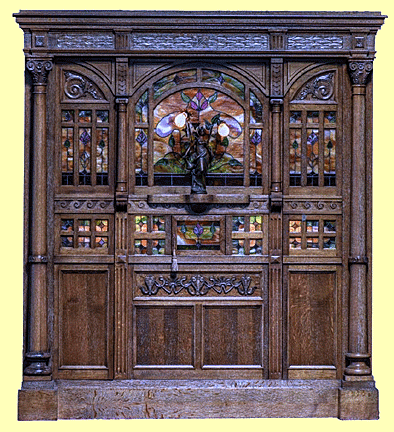 Designed
to play a wide variety of music spanning from polkas to ragtime, dance
organs were always a favorite. They featured a variety of percussion and
visuals, often accompanied by real accordions. These were incredibly
popular in dance halls and cafes in Europe. Designed
to play a wide variety of music spanning from polkas to ragtime, dance
organs were always a favorite. They featured a variety of percussion and
visuals, often accompanied by real accordions. These were incredibly
popular in dance halls and cafes in Europe.
Today, there are only a few dozen Wurlitzer Style 30-A Mandolin
PianOrchestras left in existence, and they’re some of the most valuable
and cherished of automatic musical instruments. Very few automatic
instruments play ragtime and other early American jazz quite like a
Wurlitzer PianOrchestra. Its variety in percussion, instrumentation, and
registers enabled it to produce the sound of both an orchestra or a
ragtime band.
Player pianos outsold regular pianos in the early 20th century. The foot
pumped player is still common in homes to this day and serves as a link
to the past, playing music exactly as it did decades ago. Reproducing
pianos are able to almost perfectly replicate the sound of a live
pianist, be the music classical, popular, or a complex jazz piece!
Commercial coin operated pianos drew customers to speakeasies,
restaurants, hotels, and made money while doing it.
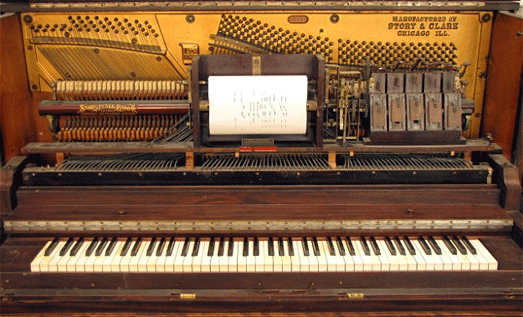
After the enactment of Prohibition, cabinet nickelodeons or
coin-operated player pianos became extremely popular after the
Prohibition was enacted. These small pianos were able to fit in just
about any corner of a speakeasy. Featuring a fairly large amount of
instrumentation and percussion, these truly excelled at being some of
the most innovative music machines.
The Market for Mechanical Music Machines
As with other antiques, condition, rarity and market demand affect the
price. Also, some of these pieces are too large for the average home.
And because they’re machines, they need to be serviced. Music boxes
aren't just decorative items; they must be in tune to sound their best.
While music boxes may need tuning if restoration is required, after
tuning music boxes usually stay that way. But the pneumatic machines
like nickelodeons, orchestrions, etc. need periodic tuning much like a
traditional piano or organ or any other musical instrument. Above all,
it’s the sound of mechanical music that resonates within us, capturing
the collector's heart.
LISTEN TO THIS 19TH-CENTURY SWISS CYLINDER MUSIC BOX
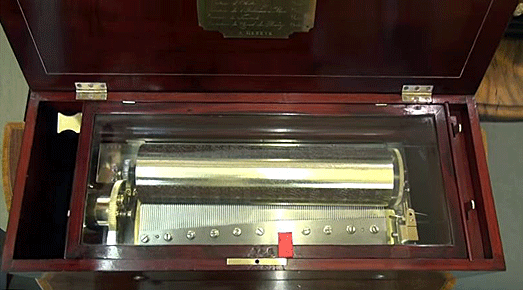
This fine quality six air Overture music box was made in Geneva around
1860 by one of the principal manufacturers of the time. It plays 6
overtures— Balfe's Bohemian Girl, Donizetti's Don Pasquale, Othello,
L'Italienne a Alger & Tancrede by Rossini, and Auber's Cheval du Bronze.
<
Back to Antiques Archives
Next Article >
|
